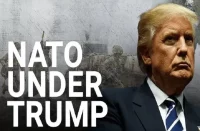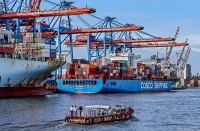India is taking advantage of the US-Chinese “trade war”.
The Times of India reported that New Delhi sees a valuable opportunity for its companies to profit during the current global trade tensions between those two economic superpowers, prudently drawing up a list of which niches it could fill in both of them due to their newly imposed tariffs against the other. This is pretty much the economic manifestation of India’s policy of so-called “multialignment”, which in this instance is much less controversial than its political and military dimensions because it’s difficult to interpret this as being at the expense of one or another player. Simply put, India intends to opportunistically exploit the situation to its advantage, which is its sovereign right, and it might even make progress on reaching its desired free trade agreement with the US throughout the course of this campaign.
The US is extremely unlikely to ever return back to its old order of business with China even in the event that the two reach a major trade deal with one another to end the “tariff war” because America doesn’t ever want its rival to have the same level of economic influence over it as it did in the past. The solution that some strategists have proposed is for the US to “diversify” its trade ties with other Asian countries in order to “balance out” its relationship with China, which is in essence what the former Trans-Pacific Partnership (TPP) was supposed to be all about. Trump derailed that specific proposal right after entering office, but he nevertheless continued to expand the US’ economic ties with its Asian partners on a bilateral basis instead.
India was never party to the TPP talks but is nowadays increasingly emerging as the US’ desired long-term counterweight to China. There’s close to no chance that the South Asian BRICS member could replace is East Asian counterpart when it comes to America’s grand economic strategy, but what it can do is function as a low-wage labor destination for US companies to eventually re-outsource their Chinese-based companies to if their government gives them low-tax or -tariff incentives per a future free trade deal with India. The formerly Chinese-occupied niches that India is already planning to fill in the US marketplace could be a realistic starting point for beginning their free trade talks and deciding which spheres should be immediately prioritized.
 Having said that, there’s always the chance that the talks fall through for a variety of reasons, but mostly those related to the sensitivities of India’s “balancing act” with Russia and Iran. The US is very uncomfortable with New Delhi’s decision to purchase S-400s and continue importing Iranian resources, so there’s always a possibility that something goes wrong in their trade negotiations because of it and these grand economic plans are derailed. Although it appears at this moment to be unlikely, that scenario could lead to India moving closer to China and making progress on the Beijing-proposed Regional Comprehensive Economic Partnership (RCEP) by building off of the formerly American-occupied niches that it intends to fill.
Having said that, there’s always the chance that the talks fall through for a variety of reasons, but mostly those related to the sensitivities of India’s “balancing act” with Russia and Iran. The US is very uncomfortable with New Delhi’s decision to purchase S-400s and continue importing Iranian resources, so there’s always a possibility that something goes wrong in their trade negotiations because of it and these grand economic plans are derailed. Although it appears at this moment to be unlikely, that scenario could lead to India moving closer to China and making progress on the Beijing-proposed Regional Comprehensive Economic Partnership (RCEP) by building off of the formerly American-occupied niches that it intends to fill.
As a result of its economic “multialignment”, India is now an even more intense object of competition between the US and China than ever before.
The post presented is the partial transcript of the CONTEXT COUNTDOWN radio program on Sputnik News, aired on Friday Oct 26, 2018:
DISCLAIMER: The author writes for this publication in a private capacity which is unrepresentative of anyone or any organization except for his own personal views. Nothing written by the author should ever be conflated with the editorial views or official positions of any other media outlet or institution.














Comments